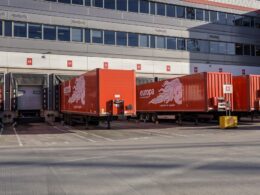Logistics—especially in the last mile—can be complex, expensive, and difficult to optimise. And when a challenging economic climate spurs concerns about operating costs and margins, logistics can become a key area of opportunity for companies to realise efficiencies by investing in new technology.
Of course, the economic downturn makes the choice of technology provider much more difficult, as many of them will be experiencing their own challenges and won’t be able to invest significantly in innovation, new features, and product enhancements. When growth and innovation aren’t full-steam-ahead across the board, how do you separate what’s important from what isn’t when it comes to choosing a logistics technology provider?
Innovation
When costs are up and demand is down, how important is it to seek out logistics technology that prioritises innovation? Arguably, it’s more important than ever. There is a big difference between simply cutting costs and actually optimising them—but when your technology is stagnant, you can only hope for the former.
A decade ago, the idea of leveraging AI to make logistics processes smarter and more efficient might have seemed nice enough in theory, but too lofty in practice to make much sense to a technology buyer. Now, it’s an integral part of many technology solutions, helping businesses to more accurately predict delivery ETAs and maximise their delivery capacity. And the businesses that saw the potential applications there—or at least trusted their technology provider to make the most of them—benefited not just from AI-powered improvements but from a culture of trying to get smarter, more efficient, and more streamlined.
Simply put, working with a solution provider that’s driven to innovate means that you’ll reap the immediate benefits that come from having partners that are truly invested in solving key challenges in logistics day in and day out.
SaaS Technology
The debate about SaaS technology vs on-premise has been raging for years now, but economic conditions like these make the winner clearer than ever. SaaS technology doesn’t just offer you the ability to adopt technology with less of an upfront investment, it also enables you to future proof your logistics technology and build out sustainable processes and practices.
By now, SaaS technology security standards have far surpassed those of most on-prem deployments. Some businesses still worry about the loss of control that comes with SaaS deployments—but the tradeoff is that running technology on your own servers requires more IT staff and more spending. In other words: more time and resources spent outside of your core competencies as a logistics organisation. A true SaaS platform offers you a more cost-effective deployment model with the added assurance that you’re always running the most secure up-to-date version of the platform.
Ease-of-Use
Not only is it difficult to find an efficient way to deliver goods to customers, it can also be extremely taxing from the perspective of your human resources just to create last mile logistics plans in the first place. Routing by hand can eat up hours and hours of planners’ time without yielding an efficient result, communicating with delivery customers one at a time can require an entire call centre, and finding the delivery data that you need at the moment you need it (e.g. in order to resolve an exception) can require so much time hunting through different solutions that the data is out of date by the time you uncover it.
Usability is the key to heading off these problems and reducing total logistics costs at the same time. To get the absolute most out of your people, you need to empower them with smart, automated, easy-to-use, and easy-to-navigate technology.
End-to-End Functionality
One of the big technology arguments of the past few decades has been about the merits of large, monolithic solutions vs best-of-breed solutions for individual functions. The former are often cumbersome, difficult to use, and not especially well-suited to any individual use case you might have for it. The latter can provide functionality that’s more specifically tailored to a particular task, but you run the risk of data and decision-making silos when these solutions don’t easily integrate with one another.
In hindsight, the answer was somewhere in the middle. No TMS has yet been invented that really makes it easy to plan last mile delivery routes, but a solution that only handles routing is just going to create headaches for planners when they’re trying to execute those route plans, communicate with customers, track proof of delivery, etc.
That’s why, for something like last mile logistics, you want a solution that specialises in the last mile but features the end-to-end functionality that enables you to consolidate IT and streamline logistics processes. This way, you have one system that integrates back to your TMS, ERP, etc. rather than 5 separate solutions just to manage the last mile.
In relatively tight economic conditions, it can feel difficult to justify investing in new technology, but the right software can help you optimise costs right off the bat—as long as you choose an innovative solution that’s actually set up to optimise your logistics processes to be more cost efficient from end to end.
An article by Alex Buckley from DispatchTrack.













